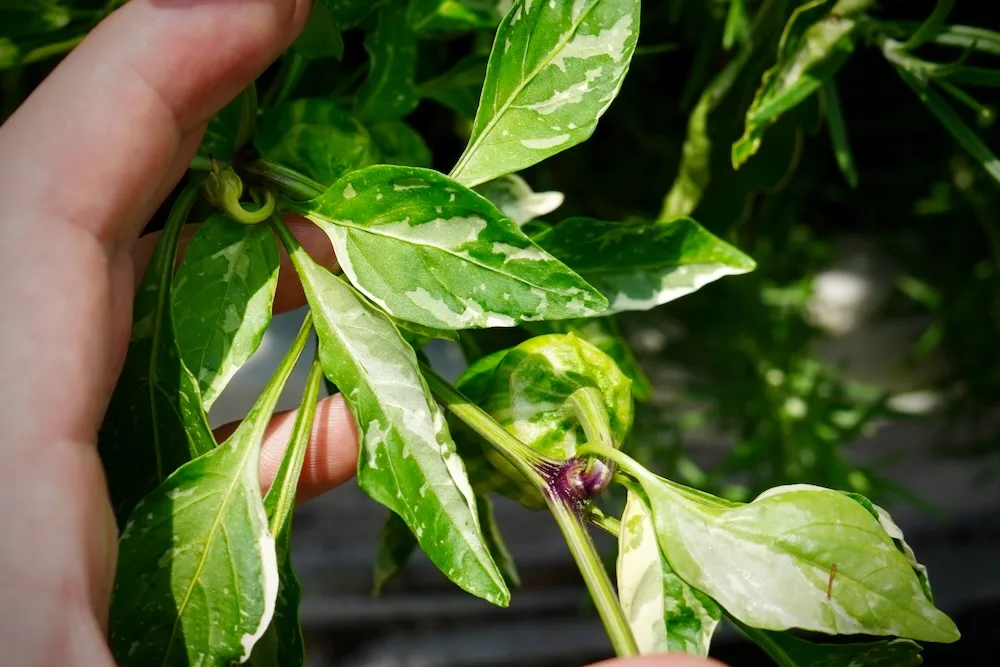There is never a dull day in the world of growing peppers. Whether you love to grow highly productive varieties, gnarly superhot chiles, or gorgeous ornamentals, there is something for you.
This article is about the candy cane pepper, one that ticks a few pepper enthusiast boxes. This plant is not only gorgeous and unique, but the peppers are also delicious and practical.

Where to buy candy cane pepper seeds. Many seed suppliers sell candy cane pepper seeds. Be sure to buy from a trusted seller, as hybrid varieties must come from a professional farm. Get seeds here from Botanical Interests.
About Candy Cane Peppers
The candy cane pepper is a hybrid variety known for its striped fruits and variegated foliage. The plants are relatively compact, at around 2-3′ in height, and can produce dozens of ripe peppers in a single season.
Since candy cane peppers are hybrids, saving seeds will lead to genetic variations, so it is not recommended. If you pick them while they’re still striped, the fruits are ready earlier than many other pepper types (about 60-65 days after transplanting).
Appearance
It can be a long wait for peppers to ripen up. However, you won’t mind waiting with candy cane peppers. The unripe pods are beautiful, with vertical streaks of white and green. The stems are sometimes white as well, making for some truly picturesque peppers.

Some seed sellers call this the candy cane chocolate pepper, as the fruits will sometimes turn a dark brown color before turning fully red. However, it is not a true chocolate pepper, as it does eventually ripen to red (some varieties finish ripening to brown).
The leaves are variegated, too, so don’t be surprised when you see splotches and stripes of ivory and green on the foliage. Each leaf and pepper can be wildly different from the – it is really fun to watch these plants grow!

Flavor
Candy cane peppers are sweet peppers, much like bell peppers. They can be picked unripe (like you would a green bell), but the flavor will be less sweet and more vegetal.
Once the peppers ripen to red, the stripes mostly disappear, turning a rich red color. This red pigmentation also brings more sweetness and nutrition, so it may be worth the wait.
Growing
Since candy cane peppers are not common in grocery stores, you’ll have to grow your own if you want some. Our plant performed well in our raised bed alongside several different pepper varieties.

The plants are shorter than average, with ours reaching just about 2 feet tall. However, the plant could easily support 10-12 peppers growing at any given time, and we were able to harvest several batches in a single season.
Since the plants are relatively compact, a simple central stake provided enough support. If your plants grow lots of pods near the top, you may want to consider using a tomato cage for better support.

Uses
Like most sweet peppers, they are extremely versatile and usable in the kitchen. From freshly chopped in salads and stir fry, to stuffed or roasted, they won’t go unused!
- Replacement for red bell. While candy cane peppers are smaller, they are essentially a red bell when it comes to flavor and uses. The walls are less thick as well, so if a large, sturdy pepper is what you want, reach for the bells.
- Snacking. These are the perfect size for eating fresh or dipping. Pick them while they are still green/white for a more crisp texture.
- Salsa. Salsa wouldn’t be complete with some form of peppers. If you like your sweet and mild, then a touch of candy cane pepper will do the trick.
- Freeze for storage. If you have an abundance of peppers, then you can easily freeze them for long term use. The frozen strips or whole peppers can be tossed right in with cooked meals throughout the winter.
If you haven’t grown the candy cane pepper, make it happen this year! They are stunning in the garden, and are easy to grow in containers on the patio or in smaller spaces.


Crazy_Bird
Tuesday 5th of September 2023
My husband and I LOVE our candy cane. It was the first one to produce, and it's even persevered through our extremely hot summer (even though the production was down). We want to know where to get seeds.
CB
Monday 5th of September 2022
I grow Candy Canes and Fish peppers ..both variegated. They are attractive plants.